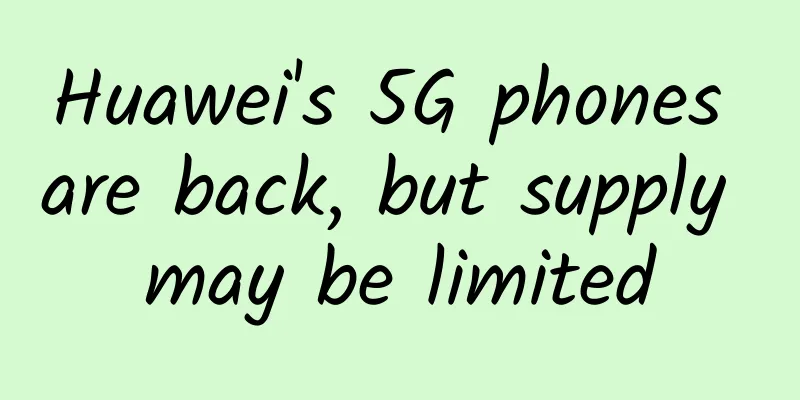Huawei's 5G phones are back, but supply may be limited

|
The Kirin 9000 chip used in the P50 Pro previously released by Huawei has an integrated 5G baseband chip, but due to the lack of a 5G RF chip, the P50 Pro cannot support 5G; the P50 uses Qualcomm's Snapdragon 888 chip, but it is a 4G version and also cannot support 5G. It is reported that Huawei will launch the 5G version of mate50, probably because it has developed its own 5G RF chip, and the RF chip does not need to be produced using restricted advanced processes, but can also be produced using mature 28nm processes. This is why Huawei is able to solve the supply of 5G RF chips. However, Huawei's 5G mobile phone SOC chips still cannot find chip foundries, because TSMC and SMIC are unable to produce mobile phone SOC chips for Huawei with 14/16nm or even more advanced processes for well-known reasons, and Qualcomm can only supply 4G chips to Huawei. In this way, even if Huawei solves the problem of 5G RF chips, its 5G mobile phone SOC chips will still have to rely on inventory. Due to well-known reasons, TSMC has been unable to produce chips for Huawei since September 15 last year. At that time, in order to ship the 5G mobile phone SOC chips produced by TSMC back to the mainland before the deadline, Huawei even chartered a cargo plane for emergency transportation. However, media reports at the time pointed out that TSMC produced 8 to 10 million Kirin 9000 chips for Huawei. Based on the rate at which Huawei consumed 20 million chips per month last year, the chip inventory Huawei had at the time might not be able to sustain the long-term operation of Huawei phones. Even high-end mobile phones using the Kirin 9000 chip have monthly shipments of around 2 million units. As such, the Kirin 9000 chip inventory at the time was estimated to be very limited to last until the release of the Mate 50. Some of Huawei's previous practices also showed that its 5G mobile phone chip inventory was already quite tight. It launched special chips such as Kirin 990E and Kirin 820E, showing that it selected some of its previous special inventory chips for the launch of 5G mobile phones. It can be naturally concluded that the mate50 5G version launched by Huawei this time can probably only use the existing limited 5G mobile phone SOC chips. Due to the limited inventory of 5G mobile phone SOC chips, even if Huawei can solve the 5G RF chip problem, the mate50 5G version will not be able to be supplied in large quantities. In summary, the editor believes that Huawei's re-launch of the 5G version of the mate50 is indeed a huge improvement, but limited by its 5G mobile phone SOC chip inventory, the 5G version of the mate50 will not be available in large quantities even if it is launched, and can only continue to be supplied in limited quantities as before, and the price may be very expensive, so should consumers choose iPhone13 or the 5G version of the mate50? |
Recommend
Case | Analyzing the effective marketing strategy in the early stage of a product
Marketing is nothing more than three things: conn...
Baidu bidding OCPC delivery optimization guide!
What I want to talk about today is search OCPC. I...
Tencent announced the adjustment of WeChat external link regulations: adhere to the user-oriented, give more choices to users, and open one-to-one scene access restrictions from today
IT Home reported on September 17 that recently, t...
Taobao promotion: Taobao mobile search traffic rules
How is Taobao Mobile search traffic distributed? ...
Redmi and BYD have reached a cooperation, Redmi K30 Pro will become the "car key" of BYD cars
Recently, Redmi released the Redmi K30 Pro produc...
Apple releases OS X 10.10.5 update, mainly to fix bugs
Apple today released OS X 10.10.5 for all users. ...
Douyin mini program development company, which one is more reliable?
Douyin mini program development company, which on...
T-Online: Survey shows that more than 94% of Germans explicitly refuse to buy Tesla
Recently, a new survey of 100,000 Germans conduct...
B2B website SEO case analysis, SEO inquiry volume data analysis!
When a company does online network promotion, whe...
[2021 Summer] Senior 3 Physics Target A+ Model Physics Chapter Progress
[2021 Summer] Senior High School Physics Objectiv...
Fight fire with fire, leaving fire nowhere to go
When you think of forest fires, what's the fi...
On which platforms can Tencent social ads be placed? Introduction to Tencent advertising resources!
On which platforms can Tencent Ads be placed? Ten...
The most "spring" seasonal vegetables, eating too much will cause poisoning! 2 eating tips for you →
What dish is the most "spring-like"? Fo...
Sweat without leaving any sweat? Why this magic tool can help you become the "most handsome guy" in the gym
During the sweltering dog days of summer, everyon...
Export suspended! What exactly is natural sand?
Recently, according to the official website of th...









